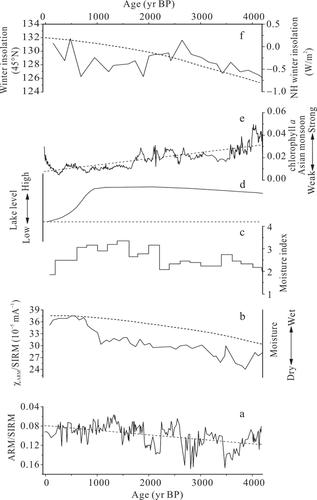当前位置:
X-MOL 学术
›
Acta Geol. Sinica Engl. Ed.
›
论文详情
Our official English website, www.x-mol.net, welcomes your feedback! (Note: you will need to create a separate account there.)
Late Holocene Moisture Changes in the Core Area of Arid Central Asia Reflected by Rock Magnetic Records of Glacier Lake Kalakuli Sediments in the Westernmost Tibetan Plateau and their Influences on the Evolution of Ancient Silk Road
Acta Geologica Sinica-English Edition ( IF 3.3 ) Pub Date : 2020-06-26 , DOI: 10.1111/1755-6724.14539 Xudong WU 1, 2 , Xingqi LIU 1 , Erwin APPEL 3
Acta Geologica Sinica-English Edition ( IF 3.3 ) Pub Date : 2020-06-26 , DOI: 10.1111/1755-6724.14539 Xudong WU 1, 2 , Xingqi LIU 1 , Erwin APPEL 3
Affiliation

|
The evolution of Ancient Silk Road (ASR) was deeply influenced by late Holocene moisture changes in Arid Central Asia (ACA). Nevertheless, controversies in Holocene moisture change pattern of ACA and poorly–constrained age models of related studies have made the discussion about late Holocene moisture changes in ACA and their influences on the evolution of ASR difficult. Recently, a high–resolution age model during the late Holocene was established for Kalakuli Lake, a small glacier lake located in the core area of ACA. A thorough rock magnetic investigation was carried out on Kalakuli Lake sediments based on this age model. The magnetic mineral assemblage of Kalakuli Lake sediments is still dominated by primary magnetite despite minor diagenetic effects. Comparisons of rock magnetic records to parameters previously used as indicator of glacier fluctuations suggest that clastic input to Kalakuli Lake was high (low) and magnetic grain size is relatively larger (smaller), when glaciers on Muztagh Ata advanced (retreated). The ARM/SIRM ratio, a magnetic grain size proxy, is directly related to lake hydrodynamics, which are ultimately controlled by glacier fluctuations on Muztagh Ata as the result of regional moisture changes. Late Holocene moisture changes indicated by the ARM/SIRM ratio are consistent with cool/wet and warm/dry oscillations indicated by the unweighted average of biomarker hydrogen isotopic data of the C26 and C28 n–alkanoic acids in a previous study about Kalakuli Lake, most moisture change records of the core area of ACA and winter insolation of the Northern Hemisphere, but opposite to Asian monsoon evolution. Given Asian monsoon and the westerlies are mutually inhibited, we propose that late Holocene moisture changes in the core area of ACA were controlled by the intensity of Asian monsoon versus the westerlies under the governance of solar insolation. Generally increased moisture since the late Holocene indicated by the ARM/SIRM ratio favored cultural exchange and integration between the western and the eastern Eurasia, which paved the way for the formation of ASR. Coincidence between significant increase in moisture at ~200 BC suggested by the ARM/SIRM ratio and the formation of ASR indicates moisture as an important factor that facilitated the formation of ASR. The onsets of three prosperity periods of ASR in the history generally correspond to periods when moisture was relatively high, nevertheless, stagnant periods of ASR do not coincide with periods when moisture was relatively low in the core area of ACA. Disorganized correlations between stagnant periods of ASR and moisture changes in the core area of ACA suggest that moisture is not the decisive factor influencing the evolution of ASR.
中文翻译:

从青藏高原最西端的卡拉库里湖冰川沉积岩的磁记录反映的干旱中亚核心区晚全新世水分变化及其对古代丝绸之路演变的影响
古代丝绸之路(ASR)的演变受到中亚干旱(ACA)全新世晚期水分变化的深远影响。然而,ACA全新世水分变化模式的争论以及相关研究的年龄模型约束不严,使得人们难以讨论ACA的全新世晚期水分变化及其对ASR演变的影响。最近,为全新世晚期建立了高分辨率年龄模型,用于位于ACA核心区域的小型冰川湖Kalakuli湖。基于该年龄模型对卡拉库里湖沉积物进行了彻底的岩石磁学调查。尽管有少量成岩作用,但卡拉库里湖沉积物的磁性矿物组合仍以原生磁铁矿为主。将岩石磁记录与先前用作冰川波动指示符的参数进行比较表明,当穆兹塔格-阿塔山上的冰川前进(后退)时,向卡拉库里湖的碎屑输入量较高(较低),磁粒尺寸相对较大(较小)。ARM / SIRM比值(磁性颗粒大小的代表值)与湖泊水动力学直接相关,而湖泊水动力学最终受Muztagh Ata冰川波动的控制,这是区域湿度变化的结果。ARM / SIRM比值表示的全新世晚期水分变化与C的生物标志物氢同位素数据的未加权平均值表示的冷/湿和暖/干振荡一致 ARM / SIRM比值(磁性颗粒大小的代表值)与湖泊水动力学直接相关,而湖泊水动力学最终受Muztagh Ata冰川波动的控制,这是区域湿度变化的结果。ARM / SIRM比值表示的全新世晚期水分变化与C的生物标志物氢同位素数据的未加权平均值表示的冷/湿和暖/干振荡一致 ARM / SIRM比值(一种磁性颗粒大小的代表值)与湖泊水动力学直接相关,而湖泊水动力学最终受Muztagh Ata冰川波动的控制,这是区域湿度变化的结果。ARM / SIRM比值表示的全新世晚期水分变化与C的生物标志物氢同位素数据的未加权平均值表示的冷/湿和暖/干振荡一致26和C 28 n链烷酸在关于Kalakuli湖的先前研究中,ACA核心区域的大部分水分变化记录和北半球的冬季日照,但与亚洲季风演变相反。考虑到亚洲季风和西风相互抑制,我们建议ACA核心区域晚全新世的水分变化受亚洲季风强度与日照控制下的西风强度的控制。自ARM / SIRM比表明全新世晚期以来普遍增加了水分,这有利于东西欧亚大陆之间的文化交流和融合,这为ASR的形成铺平了道路。ARM / SIRM比值表明,在约200 BC时水分显着增加与ASR形成之间的巧合表明水分是促进ASR形成的重要因素。历史上,ASR的三个繁荣时期的开始通常对应于水分相对较高的时期,但AAC停滞时期与ACA核心区域水分相对较低的时期并不吻合。ASR停滞期与ACA核心区域水分变化之间的杂乱无章的相关性表明,水分不是影响ASR演变的决定性因素。ASR的停滞期与ACA核心区域的水分相对较低的时期不一致。ASR停滞期与ACA核心区域水分变化之间的杂乱无章的相关性表明,水分不是影响ASR演变的决定性因素。ASR的停滞期与ACA核心区域的水分相对较低的时期不一致。ASR停滞期与ACA核心区域水分变化之间的杂乱无章的相关性表明,水分不是影响ASR演变的决定性因素。
更新日期:2020-06-26
中文翻译:

从青藏高原最西端的卡拉库里湖冰川沉积岩的磁记录反映的干旱中亚核心区晚全新世水分变化及其对古代丝绸之路演变的影响
古代丝绸之路(ASR)的演变受到中亚干旱(ACA)全新世晚期水分变化的深远影响。然而,ACA全新世水分变化模式的争论以及相关研究的年龄模型约束不严,使得人们难以讨论ACA的全新世晚期水分变化及其对ASR演变的影响。最近,为全新世晚期建立了高分辨率年龄模型,用于位于ACA核心区域的小型冰川湖Kalakuli湖。基于该年龄模型对卡拉库里湖沉积物进行了彻底的岩石磁学调查。尽管有少量成岩作用,但卡拉库里湖沉积物的磁性矿物组合仍以原生磁铁矿为主。将岩石磁记录与先前用作冰川波动指示符的参数进行比较表明,当穆兹塔格-阿塔山上的冰川前进(后退)时,向卡拉库里湖的碎屑输入量较高(较低),磁粒尺寸相对较大(较小)。ARM / SIRM比值(磁性颗粒大小的代表值)与湖泊水动力学直接相关,而湖泊水动力学最终受Muztagh Ata冰川波动的控制,这是区域湿度变化的结果。ARM / SIRM比值表示的全新世晚期水分变化与C的生物标志物氢同位素数据的未加权平均值表示的冷/湿和暖/干振荡一致 ARM / SIRM比值(磁性颗粒大小的代表值)与湖泊水动力学直接相关,而湖泊水动力学最终受Muztagh Ata冰川波动的控制,这是区域湿度变化的结果。ARM / SIRM比值表示的全新世晚期水分变化与C的生物标志物氢同位素数据的未加权平均值表示的冷/湿和暖/干振荡一致 ARM / SIRM比值(一种磁性颗粒大小的代表值)与湖泊水动力学直接相关,而湖泊水动力学最终受Muztagh Ata冰川波动的控制,这是区域湿度变化的结果。ARM / SIRM比值表示的全新世晚期水分变化与C的生物标志物氢同位素数据的未加权平均值表示的冷/湿和暖/干振荡一致26和C 28 n链烷酸在关于Kalakuli湖的先前研究中,ACA核心区域的大部分水分变化记录和北半球的冬季日照,但与亚洲季风演变相反。考虑到亚洲季风和西风相互抑制,我们建议ACA核心区域晚全新世的水分变化受亚洲季风强度与日照控制下的西风强度的控制。自ARM / SIRM比表明全新世晚期以来普遍增加了水分,这有利于东西欧亚大陆之间的文化交流和融合,这为ASR的形成铺平了道路。ARM / SIRM比值表明,在约200 BC时水分显着增加与ASR形成之间的巧合表明水分是促进ASR形成的重要因素。历史上,ASR的三个繁荣时期的开始通常对应于水分相对较高的时期,但AAC停滞时期与ACA核心区域水分相对较低的时期并不吻合。ASR停滞期与ACA核心区域水分变化之间的杂乱无章的相关性表明,水分不是影响ASR演变的决定性因素。ASR的停滞期与ACA核心区域的水分相对较低的时期不一致。ASR停滞期与ACA核心区域水分变化之间的杂乱无章的相关性表明,水分不是影响ASR演变的决定性因素。ASR的停滞期与ACA核心区域的水分相对较低的时期不一致。ASR停滞期与ACA核心区域水分变化之间的杂乱无章的相关性表明,水分不是影响ASR演变的决定性因素。


























 京公网安备 11010802027423号
京公网安备 11010802027423号